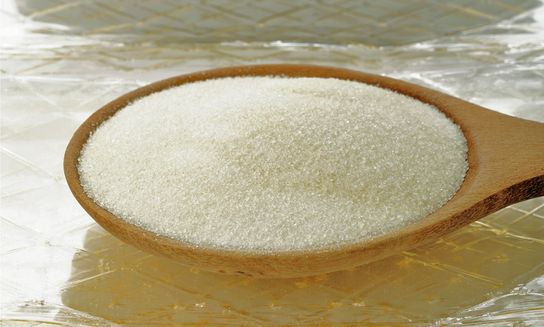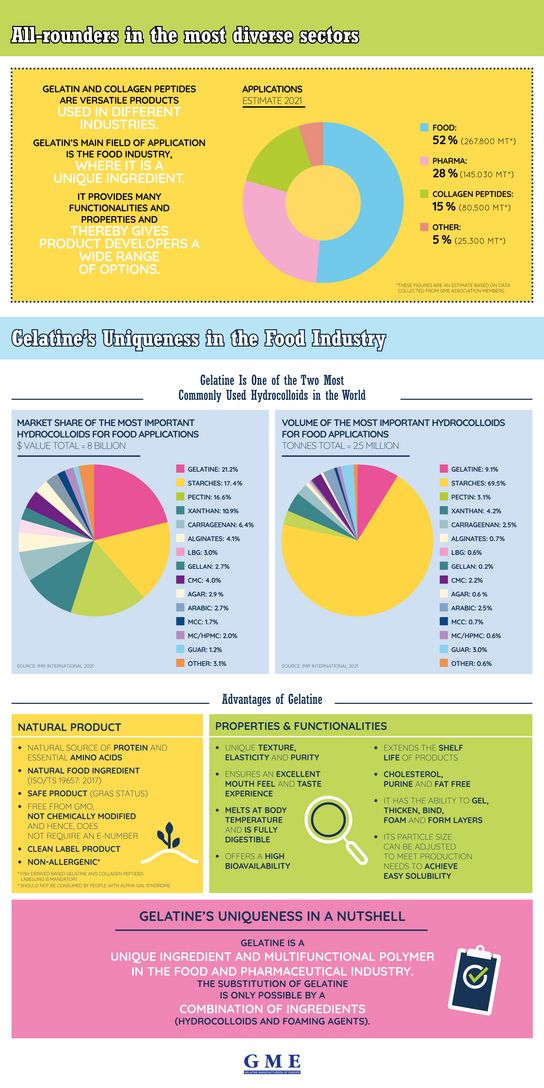Natural, healthy and versatile
Gelatine is a natural and healthy food that can look back on a long tradition. Due to its versatile properties, the pure protein offers many benefits and plays an important role in today’s food industry. Gelatine can be used to gel, thicken, stabilize, emulsify and to give a creamy consistency. But that is not all: the all-rounder is used in various economic sectors and for a wide range of products. Gelatine is especially indispensable in the pharmaceutical and photo industries.
Protein, mineral salts and water
Gelatine is a pure, natural protein made from animal raw materials that contain collagen. It consists of 84 to 90 per cent protein and 2 per cent mineral salts, with water making up the rest. Gelatine is classified as a foodstuff and, is not a food additive with an E number. As a natural food, gelatine fulfils therefore, among other reasons, the requirements of the clean label products, the demand for which is steadily growing. The use of artificial or modified additives, which need to be labelled with an E number, are avoided as much as possible in the production of food. Gelatine contains neither preservatives nor other additives and is free of fat, cholesterol and uric acid compounds.

Of great value for the organism
Without protein, there would be no human life. Over longer periods of time, the human metabolism can replace some nutrients, such as carbohydrates. Protein, however, is needed by the human body. Interestingly the human body, like other mammals, consists of approx. 30 percent collagen if water and blood is deducted. Gelatine is pure collagen and is therefore the ideal fit for the human body.
Versatile in use
The most common usage of gelatine is edible gelatine followed by pharmaceutical, photographic and technical gelatine. What makes gelatine so unique is its remarkable number of functional properties. These include the ability to gel, thicken, stabilize, foam or bind water. In addition, gelatine is 100 per cent natural and is cholesterol, purine and fat free. It does not contain any substances listed as allergen in official regulations. Another reason for being an ideal clean label ingredient.
There is no other natural ingredient in the world that combines all of the above-mentioned and necessary properties in just one food product. Many applications need several of gelatine’s properties to be able to manufacture the final product. Only a combination of various ingredients would even come close to gelatine’s properties.
A range of gelatines can be manufactured depending upon the type of application or customer requirements. There are countless types of gelatine that are distinguished based on several factors. One of the most important is the Bloom value – it defines gelatine’s ability to gelatinize. The vast majority of gelatine is produced in the form of a white, odourless and tasteless powder.
As a natural food, gelatine is thus a valuable source of protein for the human organism. Amino acids are the building blocks of proteins. The human body is able to synthesize all the proteins it needs from amino acids. There are, however, nine amino acids that the body cannot produce by itself and which must therefore be ingested regularly through the diet. They are called the essential amino acids. Gelatine contains a total of 18 amino acids, including eight of the nine essential amino acids.
Special kinds
Leaf gelatine
One special form of gelatine is leaf gelatine. It is used in the household, in cooking, in bakeries, confectionery shops and butcher’s shops, in catering and for other non-industrial applications. The gelatine is cut into squares and has a netlike pattern that is a result of the production process. At first glance, this and the elasticity of the sheets make leaf gelatine look more like an artwork. The great advantage of leaf gelatine is that it can easily be divided into portions according to recipe instructions and is thus easy to use during cooking.
Instant gelatine
Instant gelatine can be directly processed under cold conditions and is specially developed for final products that are temperature sensitive and should not be heated. Instant gelatine is often used to stabilize foods such as cakes, desserts and other sweet and cold dishes.
The all-rounder at a glance

